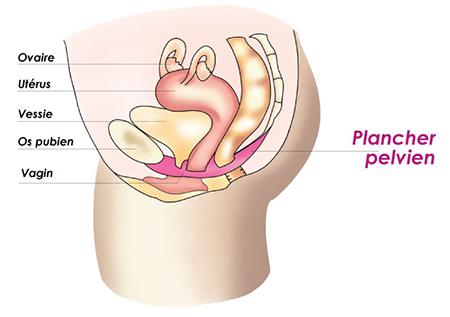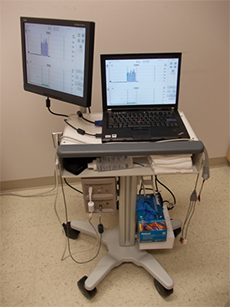Our services
Perineal and pelvic floor rehabilitaiton
Are you suffering from any problem of the urogenital and pelvic system? Whether you are experiencing a problem concerning urinary leakage due to efforts or an urgent need to urinate, discomfort caused by organ prolapse, faecal incontinence, constipation, or pain during sexual activity, we can help you.
Orthopaedic physiotherapy
Our orthopaedic physiotherapy approach takes care of your muscles, bones and joints. Our physiotherapists treat a multitude of problems, whether recent or chronic, related to the musculoskeletal or neurological system.
Perineal and pelvic floor reeducation
Are you suffering from urine losses or flatulencies when you make an effort (coughing, sneezing, jumping or exercising)? Are you experiencing frequent and/or sudden urges to urinate or to have a bowel movement that gets you rushing to the bathroom? Are you not getting to the bathroom on time? Are you suffering from any constipation? Are you feeling pain in the perineal area, to the vulva or to the scrotum? Is your sexual intercourse difficult or even impossible? If you answered yes to one or many of these questions, you are like three million Canadians who are experiencing similar problems.
These problems are mostly caused by dysfunctional perineal muscles. Theses ills could be due to many different reasons: weakened or reduced muscular control, too much relaxation or too much tension in the muscles located in the perineum area. Perineal and pelvic floor rehabilitation is a proven approach to solve these problems. You are not alone; consult and talk about it.

These muscles are located into the pelvis area between the coccyx and the pubic bone. They support the pelvic floor organs (the bladder, the uterus, and the rectum) and the continence of urines and stools. It's not always easy to properly contract the pelvic floor muscles without compensating with other muscles such as the abdominal and buttock muscles. You will get judicious advice from one of our physiotherapists to contract your pelvic muscles the right way.
Perineal and pelvic floor rehabilitation is a specialized approach to physiotherapy. Giselle Asselin , Guylaine Dûˋry and Manon Racine have taken thorough training in this domain including perineal and pelvic floor rehabilitation for women, men, geriatric patients, perineal and pelvic floor rehabilitation in gynaecology and obstetrics, adjustment and installation of pessary, as well as anorectal rehabilitation. We have been doing perineal and pelvic floor rehabilitation since 1995 and through the years, we have developed an expertise which allows us to be leaders in the region when it comes to perineal and pelvic floor rehabilitation.

We are using devices designed specially to treat problems relative to the bladder, to the rectum, to perineal muscles and pain condition. These appliances allow us to record muscular activity of our clients permitting them to visualize the contraction or the release of their muscles. That's what we call biofeedback. It's used to allow the learning of exercices and to develop muscular control.
In addition to biofeedback, we also offer muscle stimulation to trigger a contraction of the perineal muscles. It's a complementary treatment that permits the client to feel better his muscles and to ensure that suggested exercises are more effective. Muscle stimulation also helps to desensitize the perineal region in case of pain.
Biofeedback and muscle stimulation are not sufficient by themselves. To reach set objectives, the client must follow the exercises program at home, taught during the treatment period. Vaginal cones may be used to increase resistance of the muscles. To allow the client to develop more flexibility in the pelvic muscles, work with a dilator may be taught if pain is experienced during sexual intercourse.
These are used to facilitate the contraction or to help muscle relaxation. They can reduce pain or muscle tension by making progressive stretching exercises to help regain muscular flexibility, especially when you are suffering from pain problems. Small balloon techniques are used with clients suffering from constipation or rectal incontinence problems; these techniques can increase or reduce rectal sensitivity to normalize bowel movement.

If necessary, we can assess and install a pessary. The pessary is used if there is a prolapse (organ descent) and to facilitate contraction of the pelvic floor. Sometimes the muscle strength is adequate but there is persistence of heaviness/prolapse or leaks during physical or sports activities. You will be able to install the pessary yourself after receiving adequate training regarding its use and maintenance.

Once you have strengthened your perineal muscles, you must learn to use them properly! With the help of functional exercises, your physiotherapist will teach you how to use your muscles to correct your urinary incontinence, your bladder prolapse, as well as controlling your sudden urges to go to the bathroom. You may have to change some of your habits to help to fix this problem. You will learn the correct techniques to evacuate your stools to prevent or to deal with a pelvic floor prolapse as well as to ease evacuation.
Problems treated
- Urinary stress incontinence
- Urinary urge incontinence
- Mixed urinary incontinence
- Urinary incontinence following a prostatectomy
- Micturation urgency
- Prolapse of one or more pelvic floor organs
- Faecal or gas incontinence
- Constipation
- Pelvic or perineal pains
- Childrenãs incontinence
- Peyronieãs disease
Orthopedic physiotherapy
Treatments available

Manual therapy allowing mobilization of various vertebral or peripheral articulations to regain mobility and to relieve articulation pain.
Manipulations by massaging, physical and therapeutic stretching allowing to regain muscle flexibility and to release tension or spasm. A jet of cooling liquid can be sprayed on the muscle to freeze it and to gain more muscular flexibility.

Various taping techniques can be used to stabilize an articulation and/or to reduce swelling (following a sprain or a muscle malfunction), or to relieve pain (resulting from a tendinitis or a pulled muscle, for example).

Vertebral traction therapy to reduce pain, muscular tension or to allow the reduction of a hernia, most often of a lumbar nature.
Electrotherapy which combines various instruments aimed at reducing inflammation, aching, and promoting the healing of injured tissues.
Iontophoresis to reduce calcium deposits (most often found in the shoulder) as well as plaque-level inflammation in Peyronieãs disease.
A personalized exercises program suited to address the problems of everyone.
Judicious advices regarding your return to work, changes to make to adapt a workstation, your return to the practise of a sport or a leisure activity.
Problems treated
- Sports injuries
- Back, neck or head pains
- Lack of flexibility and stiff articulations
-
Problems linked to posture
(scoliosis, kyphosis, misfit workstation) - Arthritis, osteoarthritis, tendinitis, bursitis, capsulitis
- After effects from sprain or fracture
- Shoulder calcium deposit
-
After effects from orthopedics surgery
(for example, repair of tendons or meniscus) - Lactiferous duct blocking
- Any problem related to incapacitating musculoskeletal pain
- Loss of autonomy
Fees
-
Evaluation and treatment in perineal rehabilitation110,00
-
Evaluation for a pessary110,00
-
Pessary maintenance visit60,00
-
Assessment in orthopedic physiotherapy110,00
-
Treatment in orthopedic physiotherapy90,00
-
Treatment of a lactiferous duct blocking50,00



